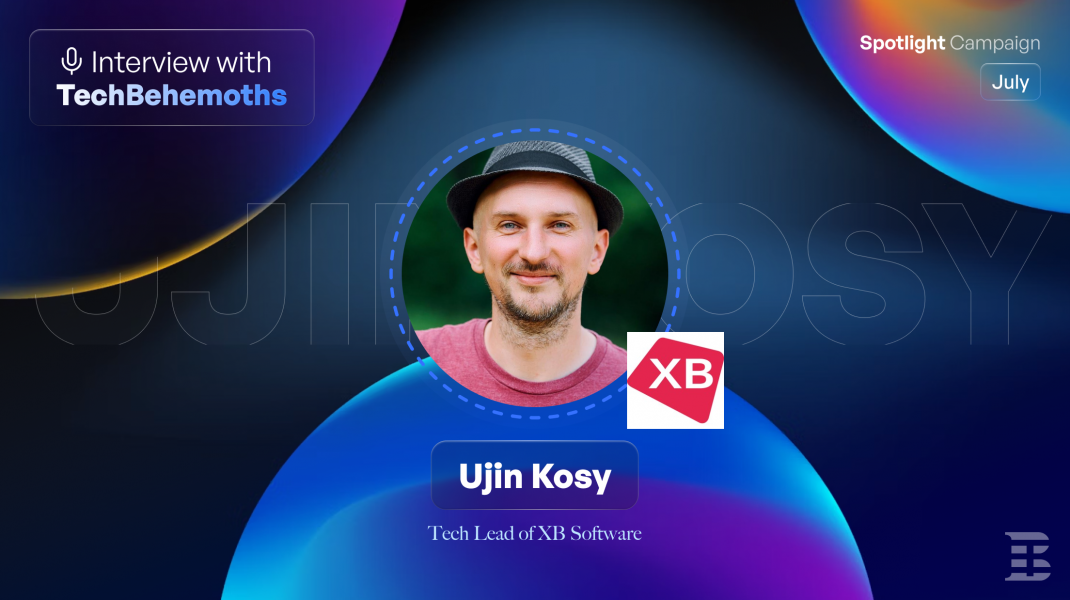Interview with Ujin Kosy, Tech Lead at XB Software

Summary
Ujin Kosy, Tech Lead at XB Software, shares his journey from childhood curiosity to leading the Webix team. Raised in Baranovichi, his early love for reading, chess, and programming shaped his mindset. Ujin started his career as a C++ developer, then moved into web development and team leadership through volunteer work. At XB Software, Ujin focuses on building flexible, user-friendly solutions using tools like Webix and DHTMLX. He emphasizes collaboration, ongoing learning, and empathy. Outside of work, he enjoys chess, fiction, and music. His advice to aspiring tech leads: be empathetic, stay curious, and strive to improve a little each day.
Welcome to this exclusive interview with Ujin Kosy, Tech Lead at XB Software. Thank you, Ujin, for accepting our invitation.
Hello Ujin! Welcome to TechBehemoths. To get started, please tell us about yourself, including your childhood, education, and professional development.
Hello everyone! Thank you for the opportunity to share my journey with all readers.
I was born and raised in a relatively small city called Baranovichi, with a population of about 150,000. My childhood was interesting, though far from wealthy. The most vivid memories I have are all connected to my family. My parents invested a lot in my education, but more importantly, they planted a deep love for reading. That love has stayed with me to this day.
But it wasn’t just about reading — it was the approach to learning that mattered most. I’d love to share a little fragment from my childhood: I often asked one of my parents to stay with me before bed and tell me a story. And many times, my dad would sit beside me and start with something like: “Son, do you see that lightbulb? It emits photons. And photons are these tiny little particles…”
To me, that sounded like a wonderful bedtime story. So you can imagine my surprise when, years later in high school, I read my physics textbook and got this strong sense of déjà vu — it brought me right back to those childhood moments. I guess it’s moments like that that teach you how to explain complex things in simple terms :)
Outside of school, I was always involved in sports — multiple kinds, actually. It was always chess plus something else: chess and handball, chess and swimming, chess and hand-to-hand combat. The second sport kept changing, but chess always stayed close to my heart. Even now, I love watching top grandmasters compete on the world stage. I’m absolutely sure that chess shaped me as a person.

Another defining moment from my childhood was discovering programming. I was about 5 or 6 years old when my brother got his first personal computer — a big deal in 1996. It was a localized analog of the ZX Spectrum, and it had a built-in BASIC programming language. I was so excited when I could copy some code from the manual and see geometric shapes appear on the TV screen (yes, we had to plug it into a TV — monitors weren’t a thing yet). That’s when I knew who I wanted to be when I grew up.
After finishing school, I went to study at the State University of Informatics and Radioelectronics, majoring in System Engineering. When I graduated, I worked as a C++ developer for several years. But then the rapid evolution of web technologies drew me in. Thanks to a strong foundation in computer science and hands-on dev experience, I successfully transitioned into web development, and that’s how I ended up where I am today.
Can you share your journey from being an engineer-programmer to leading the Webix development team at XB Software?
It was both simple and challenging. A lot of stars had to align for me to end up in this role. Back then, outside of work, I spent a lot of time helping with volunteer projects — including organizing them. That experience really helped me overcome my initial fears and insecurities about communicating with and leading a team. So when XB Software offered me the chance to lead a team, I was genuinely excited to apply those lessons in a professional setting.
I still remember how thrilled I was at the very beginning — suddenly, I had a team of people who were motivated, getting paid, and always available when needed. After working with volunteers who were helping out in their free time on side projects, working with a company team felt almost ideal.
Later on, once I had been in a management position for a while, I started paying a lot of attention to how to bring new people into the team — and I have to admit, we did a pretty good job. We almost always manage to find common ground, and the average time people stay in the department is several years.
After spending years working on volunteer projects for the sake of the idea, building something together within a company becomes so much easier.
XB Software is known for its proprietary tools like Webix and DHTMLX. How do these tools enhance the development process and improve client experience? Can you provide a notable project where customization made a significant impact?
The out-of-the-box functionality of these JS UI components allows us — following the Pareto principle — to build the core of a product really quickly and immediately see if we’re heading in the right direction for the client. These libraries have widgets for almost every possible use case — and honestly, in my 10 years at the company, there are still some I’ve never even used. It’s like a LEGO set: all the pieces fit together nicely, and you can build pretty much any castle from your imagination.
That said, we most often use these tools for data visualization — tables, forms, and other UI components typically found in business-style applications.
As for customization, it’s a bit harder to recall one standout example, since most of the time we’re solving very specific business problems.
But if I had to name something, I’d say the most impactful cases were when we fine-tuned complex widgets so the client could seamlessly integrate them with their existing APIs.
Oh, I remember! One of the most memorable Webix-based projects we worked on was the UI/UX modernization for a construction management system that had been on the market for over two decades. The platform had been patched and extended by different teams over the years, which led to inconsistent UI patterns, rigid forms, and outdated controls — not to mention, only one (very white) theme.
The real challenge wasn’t just technical. Our client had loyal users who were used to the old system and didn’t want drastic changes, even though they also wanted more modern functionality. So we had to walk that fine line between innovation and familiarity.
Using Webix UI library, we rebuilt key parts of the UI with dynamic tables and configurable forms — but we also added a toggle that let users switch between the old and new frontends. That transitional approach helped users adjust at their own pace. And thanks to Webix’s flexibility, we could introduce new UI features without disrupting the entire system.
In the end, it wasn’t just a redesign — it was a UX evolution done on the user’s terms. That’s what made it a success.
What are the core advantages of full-cycle development for your clients, and how does XB Software excel in delivering this service?
I can say our core advantage in full-cycle development is our people. When you’re surrounded by a talented, supportive team, it’s easier to create and innovate. We’re not afraid to admit when we don’t know something, and we help each other grow—this honesty drives our success.
We have strong partnerships with the creators of Webix and DHTMLX, which give us unique technical capabilities and accelerate development. Our expertise spans multiple domains, so we understand the client's business and can guide their product from idea to launch and beyond.
How do you and your team stay updated with emerging trends in web development, such as AI integrations or advanced UI/UX designs?
We hold short Friday lectures (XB Friday) where we share new technologies and recent achievements. Right now, we’re entering the age of AI, but the key is knowing how to use it effectively! We’re always open to sharing our experiences and technical wins within the company. And believe it or not, sometimes the most useful and interesting insights come while you're just waiting in line for coffee in our kitchen :)

Besides that, we also have an internal certification system to help developers keep their knowledge up to the industry average. For example, on some projects, a developer might only work with one tech stack or browser, and to make sure their skills stay fresh, we encourage them to either take part in the certification themselves or help out as reviewers. This way, the question base stays up-to-date — and more importantly, so does the knowledge in our heads.
What are the most significant technical challenges you’ve encountered in your projects, and how did you address them?
The hardest challenges are always the unknown and the unexplored. For example, it was tough to understand smart contracts and blockchain back when there were no influencers explaining them through streams or blogs. You had to dive deep into the technical documentation to figure out how to make the technology actually useful for the problem at hand.
To test our hypotheses, we build MVPs that solve the core issue. In the case of blockchain, for example, we had to locally deploy our own server just to validate our ideas. Once that’s done, we hold brainstorming sessions around the MVP to figure out how to get the most value from the technology.
How do you ensure smooth collaboration between front-end, back-end, and design teams, especially in complex projects?
That’s a tricky question. I genuinely believe that everyone in the company wants to do their job as best as they can. No one comes to work thinking, ’Today I’ll do a 2 out of 5 performance.’ So, the key lies in communication and a shared sense of purpose. I believe that if you explain to the entire team why we’re doing what we’re doing, there will be a mutual understanding on the important matters.
I’m also a big fan of the T-shaped specialist concept — when developers know a bit about related fields. That way, the most common misunderstandings get resolved quickly and painlessly.
Among the tools and technologies you’ve worked with (React, Node.js, PHP, etc.), which ones are your favorites and why?
After 13 years of programming in various companies, I’ve come to care less about specific technologies. Every language or library has its quirks. Demos often show ideal scenarios, but once you start building a full-fledged product, the flaws show up pretty quickly.
I try to find tools that solve the problem as quickly and efficiently as possible. For example, with the current global focus on AI, most examples are written in Python. This language has its pros and cons, but if a ready-made example from the docs solves a client's problem — why use anything else?
There’s also the flip side of the coin — exotic and lesser-known technologies like Nim, Crystal, and so on. They’re amazing, but if I’m the only person in the company who can work with them, the project won’t be able to scale. So, every time, it’s about finding the golden middle ground.
When you’re not solving architectural problems or leading a team, how do you unwind?
I don’t have a huge variety of hobbies, but I really do love fiction books and chess. I’m also very interested in esports — though only as a viewer, since active participation takes a lot of time and energy. And I absolutely love listening to music and learning about the stories behind albums. Knowing the background makes each track reveal a bit more of itself, helping you experience the meaning of the song in a whole new way.
What advice would you give to aspiring tech leads or developers looking to make an impact in the custom software development industry?
Find balance. I’d recommend learning empathy — to understand the client’s problem, even if they don’t say it outright. Learn to love and respect the people around you, no matter what. And always strive to be just a little better than you were yesterday.
XB Software is one of the leading companies on TechBehemoths. If you like this interview and think that Ujin and his team can help your business. Don't hesitate to contact them via TechBehemoths or discover the agency on social media: LinkedIn.